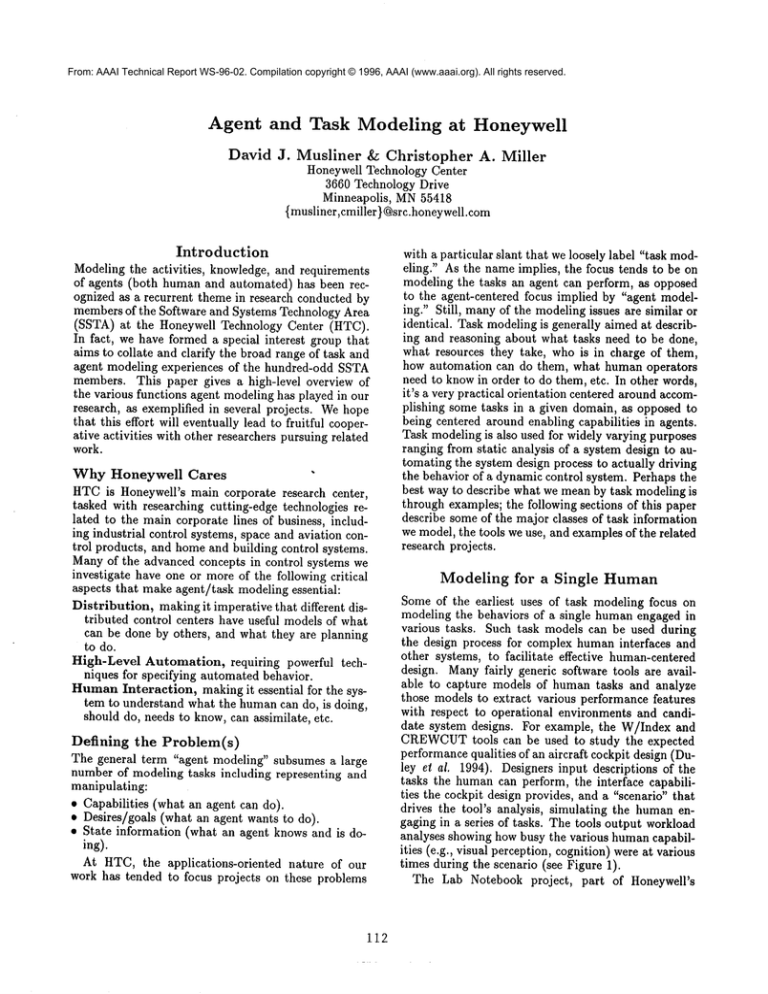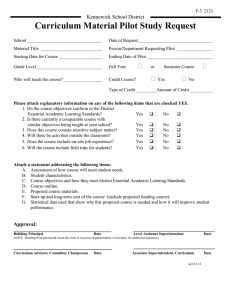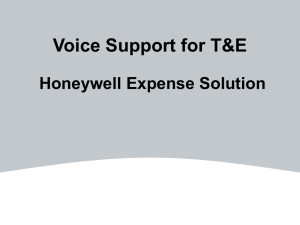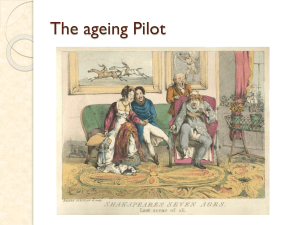
From: AAAI Technical Report WS-96-02. Compilation copyright © 1996, AAAI (www.aaai.org). All rights reserved.
Agent and Task Modeling
David
J.
at Honeywell
Musliner
~c Christopher
A. Miller
Honeywell Technology Center
3660 Technology Drive
Minneapolis, MN55418
{ musliner,cmiller } @src.honeywell.com
Introduction
Modeling the activities,
knowledge, and requirements
of agents (both human and automated) has been recognized as a recurrent theme in research conducted by
members of the Software and Systems Technology Area
(SSTA) at the Honeywell Technology Center (HTC).
In fact, we have formed a special interest group that
aims to collate and clarify the broad range of task and
agent modeling experiences of the hundred-odd SSTA
members. This paper gives a high-level overview of
the various functions agent modeling has played in our
research, as exemplified in several projects. Wehope
that this effort will eventually lead to fruitful cooperative activities with other researchers pursuing related
work.
Why Honeywell
Cares
ttTC is Honeywell’s main corporate research center,
tasked with researching cutting-edge technologies related to the main corporate lines of business, including industrial control systems, space and aviation control products, and homeand building control systems.
Many of the advanced concepts in control systems we
investigate have one or more of the following critical
aspects that make agent/task modeling essential:
Distribution, making it imperative that different distributed control centers have useful models of what
can be done by others, and what they are planning
to do.
High-Level Automation, requiring powerful techniques for specifying automated behavior.
HumanInteraction,
making it essential for the system to understand what the human can do, is doing,
should do, needs to know, can assimilate, etc.
Defining
the Problem(s)
The general term "agent modeling" subsumes a large
number of modeling tasks including representing and
manipulating:
¯ Capabilities (what an agent can do).
¯ Desires/goals (what an agent wants to do).
¯ State information (what an agent knows and is doing).
At HTC, the applications-oriented
nature of our
work has tended to focus projects on these problems
112
with a particular slant that we loosely label "task modeling." As the name implies, the focus tends to be on
modeling the tasks an agent can perform, as opposed
to the agent-centered focus implied by "agent modeling." Still, manyof the modeling issues are similar or
identical. Task modelingis generally aimed at describing and reasoning about what tasks need to be done,
what resources they take, who is in charge of them,
how automation can do them, what human operators
need to knowin order to do them, etc. In other words,
it’s a very practical orientation centered around accomplishing some tasks in a given domain, as opposed to
being centered around enabling capabilities in agents.
Task modeling is also used for widely varying purposes
ranging from static analysis of a system design to automating the system design process to actually driving
the behavior of a dynamic control system. Perhaps the
best way to describe what we mean by task modeling is
through examples; the following sections of this paper
describe some of the major classes of task information
we model, the tools we use, and examplesof the related
research projects.
Modeling
for
a Single
Human
Someof the earliest uses of task modeling focus on
modeling the behaviors of a single human engaged in
various tasks. Such task models can be used during
the design process for complex humaninterfaces and
other systems, to facilitate effective human-centered
design. Manyfairly generic software tools are available to capture models of human tasks and analyze
those models to extract various performance features
with respect to operational environments and candidate system designs. For example, the W/Index and
CREWCUT
tools can be used to study the expected
performance qualities of an aircraft cockpit design (Duley el al. 1994). Designers input descriptions of the
tasks the humancan perform, the interface capabilities the cockpit design provides, and a "scenario" that
drives the tool’s analysis, simulating the humanengaging in a series of tasks. The tools output workload
analyses showing how busy the various humancapabilities (e.g., visual perception, cognition) were at various
times during the scenario (see Figure 1).
The Lab Notebook project,
part of Honeywell’s
/
o
Baseline
with
intelligent task
re-allocation
\Time
Figure 1: Example RPAworkload profile with and without intelligent
Prototyping Technologies (ProtoTech) program, also
exemplifies the use of task modeling information in
a static,
design-time role. Prototech is an ARPAsponsored effort to develop a next-generation environment for the rapid assembly of large software prototypes. Our Prototech environment includes a Laboratory Notebook tool that helps engineers record their
design decisions and rationales.
The Lab Notebook
tool is based on a model of humanquestion asking and
answering and is designed to maximize communication
between members of a design team while minimizing
engineer workload in recording rationales. This is accomplished via an interview process which provides a
simple, familiar structure on natural language rationales. This structure can be used for later retrieval
and navigation of the recorded rationales.
Task models of a single humancan also be used in a
much more dynamic, run-time environment to control
the behavior of an interactive system. For example, the
Pilot’s Associate (PA) system, sponsored by DARPA
and the U.S. Air Force, contained models of manytasks
that pilots were expected to perform (Miller & Riley
1994). During a flight, the PA actively monitored the
human pilot’s activities and attempted to match them
against its task models, in order to understand what
information needs the human had, and what tasks the
PA should perform autonomously when, for example,
the human was too busy. One successor to the PA,
the Rotorcraft Pilot’s Associate, is described in more
detail in Section .
Modeling
for Multiple
Humans
Significant extensions to a single-agent modeling
method are required when capturing a description of
multiple agents interacting or cooperating. For example, HTChas a NASAAdvanced Air Transport Technologies (AATT) Topical Area Study program titled
113
task reallocation
between pilots.
"Analyzing the Dynamics of a Next-Generation Air
Transportation
Management System". This one-year
program is investigating methods for improving human performance simulation tools at NASAand Honeywell (such as NASA’s MIDASand HTC’s W/Index)
for evaluating candidate advanced air transportation
technology concepts long before working prototypes are
available for human-in-the-loop studies. There are two
thrusts within this program. First, we are developing
techniques, utilizing HTC’sMixed-Initiative Model of
human/machineinteractions (Riley 1989), for extending current simulation tools so that they can consider
the information flow between multiple distributed intelligent actors-- enabling them to better analyze the
complex interactions between ground crews, multiple
air crews, and intelligent
automation systems which
will characterize most advanced air traffic management
concepts. The Mixed-Initiative Model, illustrated
in
Figure 2, breaks out the various perceptual, cognitive,
and actuation capabilities of each agent, expressing
functional behaviors and interactions between these capabilities. In essence, these capabilities represent modular sub-elements of a single agent’s behavioral model,
and we are starting to use task modeling methods to
specify each capability.
Second, we are working to make the use of human/machine performance simulations more affordable
by beginning the construction of a knowledge-based
suite of model-building and analysis tools around the
simulation systems themselves. In this program we
are concentrating on the construction of an objectoriented, graphical model-building tool to facilitate
the construction of simulation scenarios and expected
agent tasks/behaviors. This tool will be built using
HTC’s Domain Modeling Environment (DOME) and
will instantiate an "information model" of the concepts
and entities used to construct mixed-initiative system
PREDICT
OPERATOR’S
BEHAVIOR
REQUESTINFORMA~ON
OPERATOR’S
GOALS
INFER
OPERATOR’S
KNOWLEDGE
em~
MACHINEINPUT
WORLD
MACHINEOUTPUT
HUMANOUTPUT
HUMANINPUT
DE-I’ERMINE
OPERATOR’S~
NEEDFORINFORMATION
|
CHECK
PERMISSION
REQUEST
PERMISSION
REQUEST
INFORMATION
PRIORITIZE
Figure 2: The Mixed-Initiative
Model of human-machine systems [from (Riley 1989)].
performance simulations. One piece of this information model will be a set of task modeling structures
and forms suited to expressing the behavior of each
MIMcapability.
this programinitially seems less related to agent modeling, the complextask modelingcapabilities (particularly the expressive temporal constraint language) are
closely tied to traditional AI planners and plan representations.
HTCalso has projects that use models of autonomous behavior in the prescriptive
plan-andexecute fashion common in AI. For example, one
project is pursuing an agent-based approach to humancomputer interaction
and dynamic generation of
context-sensitive displays. In this program, the UMPRS (Lee et aL 1994) implementation of the Procedural Reasoning System (Georgeff &: Ingrand 1989;
Ingrand, Georgeff, & Rao 1992) is being used to capture and reactively execute the procedures involved in
a search-and-rescue (SAR) domain. UM-PRSprovides
an underlying task representation
and syntax, and
complex task models are instantiated to express the
numerous SARactivities. In addition, the task models
describe howto generate effective displays based on the
current context and available display resources. Thus
explicit task modelingserves to capture several levels
of the system’s behavior.
Modeling
for Automation
Muchof the AI community’s work on "agent modeling"
is focused on capturing the capabilities and behaviors
of fully automated systems. At HTC, many of the
real-world programs are aimed at developing mixedinitiative systems, and thus modeling for automation
alone is less common.However, several technology areas have consistently involved models for fully automated systems. For example, our work on constraintbased scheduling systems uses complex task models
to describe the control semantics and temporal details of a set of tasks to be scheduled on a set of
resources (e.g., petrochemical processing units). The
TM scheduler,
SAFEbus
for example, builds static processing schedules for a networked multiprocessor system that controls the Boeing 777 aircraft information
managementsystem. The scheduler is given a detailed
model of the set of tasks to be executed, their periods, jitter, latency, and other temporal constraints,
and various additional information such as precedence
requirements. Using this task model, the scheduler
uses an iterative constraint envelope scheduling technique (Boddy, Carciofini, & Hadden 1992) to develop
a schedule that meets all the requirements. Although
Modeling
for Mixed-Initiative
Teams
As noted above, many HTCprojects involve complex
mixed-initiative systems in which humans and automation systems share responsibility and control. Task
modelsplay a variety of roles in these systems, ranging
114
i~i~i[ [~i~:~i~i!~’~i
i~:ii~] li
i ~i~!~i~:ii~
Pre-MissionData ~:~1
~~] =
"~
Mission
Equipment
Package
(Sensorsete)
External
: ; ~!~i ~i;~i
Cockpit
Situation ~ !~!i~Z~i ~ Informatmn
Manager
Assessment I’~:...
~i!~~:.:-I:: i:~
~1
~
~!~iI
~
i ~
i ~i~
Fusion
7!:¢,~i i!
~i~i~
i,!i!
l Planning [~ !~ ~ ~! ~:~
Internal
I,,~;~::Controls,D,splays,
I,,.~:,,ili:.i
..............
Situation
[:,;;,~,;~i:~21!ii’
i~I~,i~,~
Mission
Processing ;~ii
i
Assessment Li
~’.
l/ ;.~;i ~i~ ~
~;~!~1n
~t
= I~i~i~:~:~:~!~:!~!i:
liii~iii~
~i i ~
~i:il
I~!~
i i!i~it.~ii
,:i:~i~ ;~~!,iil
’I:’~!~.~’=~’~
~.!~i
~’~1
Pilots
Figure 3" The RPACognitive Decision Aiding System Architecture.
from the design-time analysis illustrated in the above
AATTexample to specification of run-time behavior
to the target information form for learning systems.
Rotorcraft
Pilot’s
Associate
(ttPA)
The RPA program is a five-year Advanced Technology Demonstration (ATD) sponsored by U.S. Army’s
Aviation Applied Technology Directorate to develop,
extensively evaluate, and flight-test an intelligent associate system in the cockpit of an advanced Army
attack helicopter. The objective of this program is
to establish revolutionary improvements in combat helicopter mission effectiveness through the application
of knowledge-based systems for cognitive-decision aiding and the integration of advanced pilotage, target
acquisition,
armament and fire control, communications, controls and displays, navigation, survivability
and flight control equipment. Similar to the Pilot’s Associate programs, the RPAwill consist of a suite of five
cooperating knowledge-based systems whose collective
goal will be to assist the aircraft crew in understanding
the vast array of battlefield information, planning the
mission, and managing the complex systems of an advanced helicopter (McBryan & Hall 1994). Figure
illustrates
the overall architecture for the RPAsystem. Task modeling plays significant roles in several
of the system modules and their inter-module communications.
Honeywell is participating in the design, development and evaluation of the Cockpit Information Manager (CIM) module (Miller & Riley 1994). Overall,
RPAarchitecture relies on task modeling to coordinate
its cooperating knowledge-based systems. The situation assessment modules must recognize and announce
the tasks that the pilots are pursuing, as well as the
external situation, potentially including the task plans
being pursued by other entities in the domain. The
115
planning module uses this information to generate a
projected course of action for the automation system
and the humans, and again this is essentially expressed
as a task model. Then the CIMuses this task modeling information to actively managethe cockpit displays and interaction mechanisms.Figure 4 illustrates
the CIMarchitecture and shows several roles for task
models, including the inputs to the CIMsystem, the
outputs of the crew intent estimator module, and the
stored elements of the goals/side-effects modeling module.
At HTC, we are using a set of workload assessment
and humanfactors analysis tools to optimize crewstation design and function allocation policies between
multiple crew membersand automation during the initial phases of the program. In addition, the policies developed using these analysis tools will be captured in
dynamic information managementand function allocation algorithms to increase the flexibility and contextsensitivity of the CIM.
Learning
Systems
for
Pilot
Aiding
(LSPA)
The LSPA program was a 3.5 year effort sponsored
by AFWAL’sCrewstation Directorate to demonstrate
machine learning applications for large scale, pilotaiding expert systems-- specifically, Lockheed’s Pilot’s
Associate. The program consisted of two interacting
parts, Learning System for Tactical Planning (LSTP)
and Learning System for Information Requirements
(LSIR). Our goals were to facilitate knowledgeacquisition and knowledge engineering by semi-automatically
learning tactical plans and pilot information requirements from simulator-flown learning instances, thereby
reducing the time and cost associated with knowledge
base scale-up and modification. At program end, LSTP
has successfully used an Explanation-Based Learning
approach to learn eight new leaf-level plans for the
I
Plot1
Pilot2
|
1.
2.
3.
4.
TaskandContextKnowledge
Information
Requirements
Knowledge
Information
PresentationKnowledge
SelectionMechanism
Figure 4: The RPA Cockpit Information
model-intensive data for information exchange in human/machine and human/human interactions.
Tactics Planner (TP) module of the PA, substantially
fleshing out the TP branches for degrading SAMsites
and evading missiles. LSIR has developed a "linked
learning" technique which takes a newly-learned plan
from LSTP and reasons about the information a human pilot will need in order to perform that plan. The
result is an Information Requirements data structure
which is used by the Pilot-Vehicle interface module of
the PAin selecting and configuring displays for Information Management. Experimental evaluation of the
LSPAsystems indicates that when human knowledge
engineers use LSPAoutputs, even novices can create
plans and IR data structures faster and with greater
accuracy and completeness than when relying on traditional knowledgeengineering techniques alone.
Explanations
for
Model-Based
Manager.
¯
Summary
These examples display the broad scope of task modeling and agent modeling efforts at the HoneywellTechnology Center. Many of these projects have a more
human-centered focus than current AI software agent
modeling work, but we see many commonthemes and
approaches. In the long term, we hope to develop
shared agent modeling representations and tools that
can fulfill several of the roles currently addressed by
separate techniques. At HTC, task modeling supports
manyroles including:
¯ Automated control and associate systems, through
dynamic planning, scheduling, and execution of task
models.
¯ Domain knowledge acquisition,
through models of
discourse and communication, as well as abstract
task models representing structural constraints on
the target knowledgebeing acquired.
¯ Intelligent tutoring systems, using task models aa
both the object to be trained and as a guide for how
to provide training.
¯ Intent inferencing (plan recognition), by mapping
observed user activities against existing task models.
¯ User interface generation, using task models as the
basis of determining what information a user needs.
Systems
The purpose of this IR&Dproject was to provide explanation and "argumentative" capabilities for a modelbased diagnostic expert system. The target application was tIoneywell’s model-based Flight Control
Maintenance and Diagnostic System. We developed
an approach to organizing the presentation of large
amounts of model-based data in an interactive format
patterned after human-humanexplanatory and argumentative discourse in order to increase user trust,
accuracy of usage, and embedded training potential.
The discourse approach was a convenient, powerful,
intuitive and broadly applicable method of organizing
116
¯ Interface design and analysis, using explicit task
models for domain-specific scenarios as the testbed
against which to evaluate various hypothetical interface designs.
¯ Information management and interaction
management systems, which may build task models dynamically (in conjunction with an intent inferencing or
task tracking system), to provide adaptive assistance
to human operators.
References
Boddy, M.; Carciofini, J.; and IIadden, G. 1992.
Scheduling with partial orders and a causal model. In
Proceedings of the Space Applications and Research
Workshop.
Duley, J. A.; Miller, C. A.; Schultz, E.; and Hannen,
M. 1994. A human resource based crew station design
methodology. In Proc. AIAA/IEEE Digital Avionics
Systems Conference, 233-238.
Georgeff, M. P., and Ingrand, F. F. 1989. Decisionmaking in an embedded reasoning system. In Proc.
Int’! Joint Conf. on Artificial Intelligence, 972-978.
Ingrand, F. F.; Georgeff, M. P.; and Rao, A. S. 1992.
An architecture for real-time reasoning and system
control. IEEE Expert 34-44.
Lee, J.; Huber, M. J.; Durfee, E. H.; and Kenny,
P. G. 1994. UM-PRS:An implementation of the procedural reasoning system for multirobot applications.
In Proc. AIAA/NASAConf. on Intelligent
Robots in
Field, Factory, Service, and Space.
McBryan,B., and IIall, J. 1994. Engineering approach
for rotorcraft pilot’s associate cognitive decision aiding system development. In Proc. AIAA/IEEEDigital
Avionics Systems Conference, 76-81.
Miller, C. A., and Riley, V. 1994. Achieving the
associate relationship: Lessons learned from 10 years
of research and design. In Proc. IEEE Int’l Conf. on
Systems, Manand Cybernetics.
Riley, V. 1989. A general model of mixed-initiative
human-machine systems. In Proc. HumanFactors Society 33rd Annual Meeting, 124-128.
117




